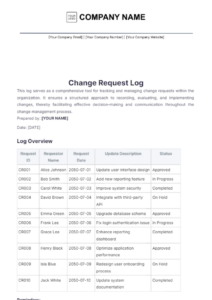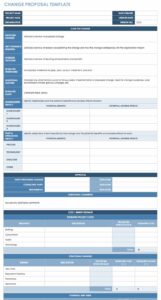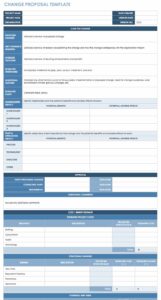Maintaining such organized records offers several advantages. It enhances transparency and accountability by providing a clear audit trail of all requested changes. This allows stakeholders to understand the evolution of the project and the rationale behind any deviations from the original plan. Furthermore, it helps prevent scope creep and budget overruns by providing a mechanism for evaluating the impact of each change before implementation. This structured approach promotes better project control and increases the likelihood of successful project delivery.
This organized approach to managing changes is essential for projects of all sizes and complexities. The following sections delve into the key components of a well-designed document for tracking changes, best practices for its implementation, and common challenges encountered in managing change requests.
Key Components of a Change Request Log
Effective management of project modifications requires a structured approach to documentation. A well-designed change log incorporates several key components to ensure comprehensive tracking and informed decision-making.
1: Unique Identifier: A unique number assigned to each request allows for easy tracking and referencing.
2: Request Date: The date the change was submitted provides a chronological record of modifications.
3: Requester: Identifying the individual or team requesting the change ensures clear communication and accountability.
4: Description: A concise and clear explanation of the proposed change is crucial for understanding its scope.
5: Justification: The rationale behind the change request helps stakeholders assess its necessity and potential benefits.
6: Impact Assessment: Evaluating the potential impact on project scope, timeline, budget, and resources is essential for informed decision-making.
7: Approval Status: Tracking the approval status (e.g., pending, approved, rejected) provides visibility into the change management process.
8: Implementation Details: Documenting the assigned resources, implementation plan, and completion date ensures effective execution of approved changes.
These components provide a comprehensive framework for documenting and managing project changes, promoting transparency, and facilitating effective communication among stakeholders. A thorough record allows for informed decisions regarding the impact of each modification on project outcomes.
How to Create a Project Change Request Log
Establishing a structured process for documenting modifications is crucial for effective project management. The following steps outline how to create a robust change request log.
1: Choose a Format: Select a suitable format, such as a spreadsheet, database, or dedicated software. Spreadsheets offer simplicity, while databases and software provide advanced features like automated notifications and reporting.
2: Define Columns: Establish columns for each key component, including a unique identifier, request date, requester, description, justification, impact assessment, approval status, and implementation details. Tailor columns to specific project needs.
3: Establish a Naming Convention: Implement a clear and consistent naming convention for the log file itself and individual change requests. This facilitates easy identification and retrieval of information.
4: Define Access Levels: Determine who can access, edit, and approve change requests within the log. This ensures proper control and accountability within the project team.
5: Set a Review Process: Establish a clear process for reviewing and approving change requests. Define roles and responsibilities for reviewing, evaluating, and authorizing modifications.
6: Train the Team: Provide training on how to use the log, ensuring all team members understand the process for submitting, reviewing, and approving change requests.
7: Regularly Review and Update: Periodically review the effectiveness of the change management process and update the template or procedures as needed. This continuous improvement approach maintains its relevance and utility.
A well-defined change request log provides a centralized repository for tracking modifications, promoting transparency, and ensuring informed decision-making throughout the project lifecycle. Its consistent use supports successful project outcomes by enabling effective scope, schedule, and resource management.
Effective management of change is critical to project success. A standardized document provides a structured mechanism for capturing, evaluating, and implementing modifications, fostering transparency and accountability throughout the project lifecycle. Key components, such as unique identifiers, detailed descriptions, impact assessments, and approval statuses, ensure comprehensive documentation and informed decision-making. A well-defined process for creating, accessing, and updating this documentation further enhances its utility in controlling scope, schedule, and resources.
Organizations that prioritize structured change management practices are better equipped to navigate the dynamic nature of projects. Implementing a robust system for documenting and tracking modifications empowers teams to anticipate challenges, mitigate risks, and ultimately deliver successful project outcomes. The investment in establishing and maintaining such a system contributes significantly to achieving project objectives and overall organizational success.


